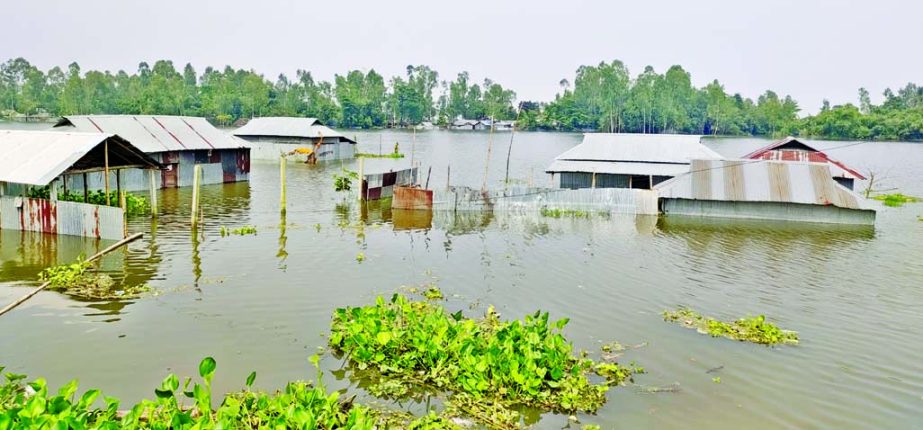
Staff Reporter :
The overall flood situation in the country’s northern and central region has worsened further following rise in the water levels of major rivers.
Floods also spread in the upper central and central regions on Monday worsening the situation in Manikganj, Munshiganj, Faridpur, Madaripur, Chandpur, Rajbari, Shariatpur, Dhaka, Sirajganj and Tangail, said Md Arifuzzaman Bhuiyan of the Flood Forecasting and Warning Center (FFWC).
So far, four million people have been marooned in the flood-affected 899 unions of 151 upazilas under 31 districts, according to the National Disaster Response Coordination Center (NDRRC).
The flood victims in the submerged areas have been passing miserable life with inadequate relief, locals said.
In Madaripur about 90,000 people have been suffering as the fresh flood is inundating new areas in four upazilas of the district every day.
Low-lying areas on the Padma River bank in Shibchar upazila went under flood water seven days ago and more areas in Rajoir, Kalkini and Sadar upazilas are being submerged. Low income people of these areas are facing trouble due to lack of dry food, pure drinking water and sanitation problems.
According to an estimate, 33,700 families have been affected by flood. Shortage of food as well as government assistance made the situation unprecedented miserable.
In Gaibanda, more than 1.5 lakh people in 40 unions of six upazilas have been marooned. Unemployment and low income people are more affected by the three phases of flood. The poor families are without food under the open sky.
The affected people also claimed inadequate supply of government relief.
In Kurigram, people in the flood affected areas in Kurigram are complaining of shortage of food and government assistance as they struggle to survive and worry over a bleak future. An estimate of 300,000 people in 60 unions of nine upazilas have been marooned while 70 feet area of Burirhat and Gaburhelan spars in Rajarhat upazila were gobbled by strong currents.
About 2,000 houses in the district have been lost in the river while 50,000 houses were damaged. According to the District Health Service sources, over 40,000 tube-wells of the district have gone under water, sparking a pure drinking water crisis.
In Pabna, around 20,000 families of 100 villages of five upazilas have been marooned, as they were waterlogged. Many of the affected areas are also facing massive river erosion.
Four unions have been affected for immense waterlogging, while several hundred families in the affected areas have been marooned in Sujanagar Upazila.
Some villagers have been evacuated from several flood-hit areas while many others have been found stranded.
The shortages of pure drinking water and foods intensified the sufferings of the marooned people.
Many flood victims took shelter on makeshift houses in higher areas, high lands and roads as their homesteads have gone under floodwaters in 31 districts.
Some of the displaced people have been passing their days under the open sky as their dwellings have been washed away by floodwaters while waterborne diseases like diarrhoea have broken out in the flooded areas.
They are seeking assistance from the government and other organisations.
Local sources said, the government has speed up relief distribution among flood victims in the affected areas, but these are not adequate.
Unremitting rise of water level of the most rivers in the Ganges Basins triggered by onrush of water from upper catchment for the last couple of days further worsened the flood situation in the country which left 12 persons dead .
Of the total 30 river points in Ganges Basin regularly, water levels increased at 19 stations, while decreased at eight stations and remained stable at three points at 9 am today aggravating the flood situation in the char (river bed) and other low-lying areas.
But, the rivers were flowing below danger level at 22 points, while six points above the danger mark this morning.
Local office of Bangladesh Water Development Board (BWDB) has recorded a rising trend of water levels in almost all points like Pankha, Rajshahi, Hardinge Bridge at paksey, Talbaria, Goalunda and Mawa in the past 24 hours ending 9 am today, said Mukhlesur Rahman, Superintending Engineer of BWDB.
Water level of the Ganges River increased by 12 centimetre (CM) at Pankha in Chapainawabganj, eight cm at Rajshahi, three cm at Hardinge Bridge and Talbaria points each while the level in the Padma River increased by two cm each at Goalunda and Mawa points.
But the Ganges River was flowing 163 cm and 171 cm below the danger level at Rajshahi and Pankha points respectively, he added.
As floodwaters have started receding, river erosion has taken a serious turn in 40 villages under 25 unions of Gangachara, Kaunia and Pirgachha upazila in Rangpur. Among the villages, Shankardaho of Lakkhitari union in Gangachara is the worst-hit. Already 80-85 percent areas of the village have been lost to the erosion by Teesta River.
The three phases of flood have badly damaged the roads in nine upazilas of Sunamganj and two upazilas of Sylhet district, shattering communication in the division and causing vast suffering to the people.
According to officials of Local Government Engineering Department (LGED) and Roads and Highways Department (RHD), around one thousand 210 km of roads in the districts have been destroyed by flood continuing from June 25.
Kamrul Islam Amirul, Chairman of Nandirgaon Union in Gowaingaht upazila of Sylhet district said, the bricks and the soil on the roads have been washed away by floodwater.
Sylhet LGED Executive Engineer SM Mohsin said though flood water is reducing, around 275 km of roads are still under by water, adding that the loss could be around Tk 200 crore. “The roads will be repaired after the water recedes.” he added.

